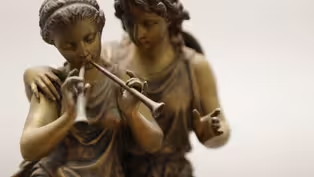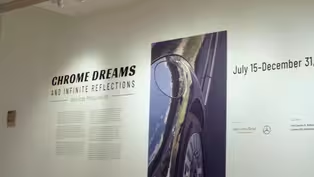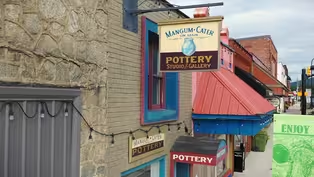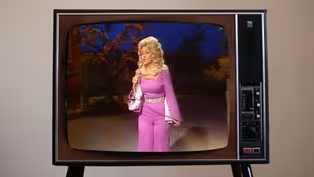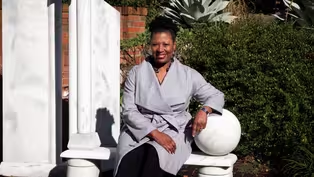
Creative State
Season 20 Episode 7 | 26m 46sVideo has Closed Captions
NC Weekend explores the current arts scene around the state.
North Carolina Weekend explores the current arts scene around the state including a Women in Country Music Exhibit in Raleigh, a bronze foundry in Seagrove, a tour of the Gregg Museum of Art and Design on the campus of NC State, pottery at Mangum Cater Studio in Sparta, and a photorealism exhibit at Reynolda House Museum of American Art.
Problems playing video? | Closed Captioning Feedback
Problems playing video? | Closed Captioning Feedback
North Carolina Weekend is a local public television program presented by PBS NC

Creative State
Season 20 Episode 7 | 26m 46sVideo has Closed Captions
North Carolina Weekend explores the current arts scene around the state including a Women in Country Music Exhibit in Raleigh, a bronze foundry in Seagrove, a tour of the Gregg Museum of Art and Design on the campus of NC State, pottery at Mangum Cater Studio in Sparta, and a photorealism exhibit at Reynolda House Museum of American Art.
Problems playing video? | Closed Captioning Feedback
How to Watch North Carolina Weekend
North Carolina Weekend is available to stream on pbs.org and the free PBS App, available on iPhone, Apple TV, Android TV, Android smartphones, Amazon Fire TV, Amazon Fire Tablet, Roku, Samsung Smart TV, and Vizio.
Providing Support for PBS.org
Learn Moreabout PBS online sponsorship[piano intro] - [Deborah] Next on "North Carolina Weekend," join us from the GREGG Museum of Art and Design as we explore our creative state.
We'll visit the Power of Women in Country Music exhibit, a sculpture park in Seagrove and a photorealism show at the Reynolda.
Coming up next.
- [Announcer] Funding for "North Carolina Weekend" is provided in part by Visit NC, dedicated to highlighting our state's natural scenic beauty, unique history, and diverse cultural attractions.
From the Blue Ridge and the Great Smoky Mountains across the Piedmont to 300 miles of barrier island beaches, you're invited to experience all the adventure and charm our state has to offer.
[light music] ♪ - Welcome to "North Carolina Weekend" everyone.
I'm Deborah Holt Noel and this week we are highlighting our creative state.
From North Carolina State University featuring music, sculpture, pottery, and more.
I'm here at the GREGG Museum of Art and Design on North Carolina State's campus in Raleigh.
The Visual Arts Center rotates and maintains a collection of over 40,000 objects spanning many cultures, designs and disciplines.
Now let's head to the home of pottery to admire bronze.
That's right.
One of Seagrove's best kept secrets is a metal foundry where Chelsea Goodnight discovered a sculpture garden, a gallery, and a pair of artists dedicated to preserving history.
- To me the best sculpture is sculpture that creates questions in your mind.
Why was it done?
What was it done for?
What's it purpose?
It's theme, what does it express?
The first time I ever had a casting made of one of my sculptures it was the most wonderful, educational experience in the world.
It instilled in me that if you really want to do something and you mean to do it, you can do anything.
I think art is really important.
It has more purpose than just something nice to look at.
You never know where, when, or how you're gonna touch someone.
And bronze casting, it lasts forever.
That's the beauty and the allure of bronze.
It's unmistakable.
The sculpture's eternal.
That's what that's really about.
When people come in amazement that's the word I get just about every time.
Even seasoned sculptors that have been to many other art casting facilities, take away something about art and history and they truly appreciate the work we do.
That's the fulfilling part.
They can't help but see the quality and the effort that we put into everything.
If it's worth doing, it's worth doing it right.
Carolina Bronze started first as a studio art business in New Orleans.
I was a college art professor and I was told that I was too ambitious, was doing more than the administration wanted me to do.
So that summer I built my own studio next to my house, including a metal casting facility with a foundry.
Started casting metal and doing my own work, one thing led to another and here we are in Seagrove.
- Well, we chose Seagrove as our location for several reasons, but the main one was that we were really excited to be part of an artist community.
We are hoping to add not only sculpture, but fine art of all different kinds.
We feel like the more reason that people have to stop in Seagrove in addition to the pottery, the more people will come and enjoy all the things that Seagrove has to offer.
- Carolina Bronze is a one stop shopping place for sculpture.
We have a sculpture factory.
We manufacture sculpture on a large scale.
- When people think of Bronze Foundry, a lot of times they are not sure what to expect.
Often when they come for tours, they are really surprised by the number of steps that it takes to make a piece of bronze and they come away with a much greater appreciation for the process of bronze sculpture and for sculptures who make bronze sculpture as well.
The Foundry tour takes about an hour and you start in the gallery and history is explained to you and then you go through the whole process.
So you'll start with a tour of the rubber mold room, then the wax room, ceramic foundry, metal shop, and patina area.
And once you're finished with your tour of the foundry, you're more than welcome to spend time wandering around the sculpture park.
We have about 25 sculptures out there at present, both abstract and realistic.
One of the reasons that we started the sculpture park here in Seagrove was to help educate people about outdoor sculpture, public art and how it can really enhance an area and make it a more interesting place to visit.
This place is for anybody that loves sculpture.
Bronze sculpture helps not only see what the past was like, it helps you see what the present is like and helps you envision what the future might be like.
- Carolina Bronze Sculpture is at 6108 Maple Springs Road in Seagrove and they're open Monday through Friday from 8:00 AM to 4:30 PM.
Tours are available.
To find out more, give them a call at [336] 873-8291 or go online to carolinabronze.com.
An art form that has deep roots in our state is country music.
Come with us to the North Carolina Museum of History and a new exhibit called The Power of Women in Country Music, highlighting the past, present, and future of country music's greatest female trailblazers.
This exhibit is sure to lift your spirits ♪ Crazy ♪ ♪ Found myself a city boy and one night stand ♪ ♪ Jolene, Jolene, Jolene ♪ - This one is, You're looking at Country - Right.
- Hello Country.
- Well, Hello Country.
- We are at the North Carolina Museum of History in a temporary exhibit gallery where they are hosting the Grammy Museum's exhibit, The Power of Women in Country Music through late February.
Women have been part of country music for the entire history of country music.
♪ If you're looking at me, you're looking at country ♪ - These women did so much in the background that they don't always get credit for.
They were very talented musicians.
They were strong songwriters and strong business women.
- They are writing lyrics about things that their male counterparts might not be writing about.
Loretta Lynn sang about the pill.
Kacey Musgraves sang about LGBTQ rights.
Now you have people like Mickey Guyton singing about what it's like to be Black in America.
♪ You should try to be Black like me ♪ - We just thought they were really inspiring, really gritty and amazing storytellers.
It was time to talk about them.
[soft guitar music] The inspiration for curating this exhibit came from a study that was published in 2019 and that looked at country airplay.
From 2010 to 2018 and it showed that only 10% of the songs being played were by women.
So we looked at that statistic and we scratched our heads because here we are seeing a lot of great female performers winning Grammys.
Sometimes country album of the year, [background applause] sometimes album of the year.
The women are all at the top.
So why is the radio play not matching up with everything else?
So we wanted to zoom out and really appreciate all of the women of country music and what they've contributed to the genre throughout the history of it.
- Oh y'all are sweet.
[audience cheering] Thank you very much.
Thank you.
- The Power of Women in Country Music is a traveling exhibit that covers about a hundred years of history of women in the country genre starting in the 1920s with the Carter Sisters, all the way through to some new names that people will discover here for the first time.
- It features art, it features music, it features culture.
It's diverse and it's all in a history museum.
- To walk into this beautiful space and see all of this color and all these inspiring quotes and all these diverse voices, it's just really exciting.
- The exhibit features over 40, nearly 50 women represented through artifacts and up to 70 women represented through songs on the playlist and video content that you'll see when they're in the gallery.
All of the items in this exhibit are genuine artifacts, the costumes, the handwritten lyrics, the instruments they all came from, the artists themselves.
I look specifically to Emmylou Harris's Manuel Cowgirl boots.
We have Wanda Jackson's Pink Daisy rock guitar and then things like Dolly Parton's butterfly banjo, all the way to Shania Twain's "Man, I feel like a woman" outfit.
These artifacts are super emblematic, not only of the artists themselves and their attitudes, but also of this greater story of power and power through femininity and fearlessness and just really being who you want to be.
- A really interesting aspect of this exhibit is that one of the curators here at our museum has added four musicians who are from North Carolina.
- The women featured in the North Carolina portion of the exhibit are Myrtle Cooper Wiseman also called Lulu Belle, Donna Fargo, Emmylou Harris, Rhiannon Giddens, Rissi Palmer and Kasey Tyndall.
We're really excited to have Rissi Palmer's microphone here in the display of North Carolina women.
The microphone comes from her podcast, "Color Me Country," and what's so interesting about that is that Rissi's not just such a talented performer, this podcast is such an important part of country music because it tells those stories that have been forgotten over time.
- So we've had a lot of fun planning the events and programs to support this exhibit.
They include everything from family events to author series and then our concert series.
The Southern Songbird really was curated to amplify contemporary and legendary and current voices in the state.
If you come and visit this exhibit, you're gonna expect to see the Dollies, the Taylors, the Faiths, but I really hope that people pick up some new names.
You know, maybe make a playlist while you're in here cause there's a lot of music discovery to happen in this room.
We can just take a little passage through time and pick up some new favorites on our way through the exhibit.
- The power of Women in Country music is on display at the North Carolina Museum of History until February 26th, 2023.
The museum is at 5 East Edenton Street in downtown Raleigh.
And don't forget, they have several live concerts in the next few weeks.
For tickets and more information, give the museum a call at 919-814-7000 or visit them online at NCmuseumofhistory.org.
I'm here with Roger Manley, Director of the GREGG Museum of Art and Design and we are standing in front of a magnificent piece that's here at the museum.
What can you tell me about it?
- Deb, we're really glad you're here today to see this.
This is an Egyptian party tent from about a hundred years ago.
We know it was made sometime between 1922 and 1929.
For thousands of years, Egyptians have set up tents to have special events like weddings and gatherings, parties, ceremonies and things like that.
And we happened to wind up with one because a family here in North Carolina brought it back in the twenties, brought it back to the states and then never set it up.
As far as we can tell, we think they got it back here and couldn't figure out how to set it up.
So it eventually wound up in our collection and we decided to set it up and show it to the world.
- Well it is truly something to see.
Roger, tell me more about the GREGG and its relationship with North Carolina State University.
- We are the teaching museum here at NC State and we're also the collecting museum.
That means that we gather materials that can be used in teaching classes and that students can use in their research.
Yet at the same time we're a free museum for the whole community.
Anybody can come at any time that we're open and see any of our exhibits for free.
All our programming is free.
We have a nice garden and landscaping surrounding the museum that we make available to the community for all kinds of things.
So it's really a sort of a museum for the city of Raleigh and the triangle area.
- And I understand that you have over 40,000 pieces in your collection.
What do you do with the parts that aren't on display?
- Things that aren't on display are regularly brought out for other exhibitions.
We try to rotate objects in and out of the collection.
The collection that we have is largely set up to augment the teaching here at NC State.
So we have a large ceramic collection.
We have a large textiles collection 'cause you know NC State is the world's largest college of textiles, clothing, furniture, decorative arts.
The professors use and students use for their research projects.
Professors use it in their class teaching and things like that.
- Well, we are excited to be here and I look forward to exploring more of it.
Thanks so much.
- And we're delighted you could come.
Thank you.
- The GREGG Museum of Art and Design is at 1903 Hillsborough Street in Raleigh and they're open Tuesday through Saturday from 10:00 AM to 5:00 PM.
Admission is free.
For more information, you can give them a call at [919] 515-3503 or go online to GREGG.arts.ncsu.edu.
The pieces in this collection at the GREGG all look like wood, but believe it or not, they're actually ceramic.
Isn't that amazing?
You know, if you're interested in seeing the creative process, why not go behind the scenes where four artists are combining sculpture, pottery, and paintings at a small studio in Sparta.
Let's join Theresa Lisky at Mangum-Cater on Main.
[upbeat music] - Sparta has always been a beautiful, beautiful place.
- We felt like it was going to be a better, more peaceful location.
- It's quaint, the people are so nice.
- The mountains tend to draw creative people.
- [Theresa] Daniel Cater, Rob Mangum and Daniel's wife Robin Cater are artisans who live around Sparta.
They all started at different times and for different reasons, but the one constant was the pure enjoyment pottery brought them.
- And I wanted to become a potter but I'd never had my hands in clay ever.
But I loved pottery, just making something with your hands and living that wonderful, simple, basic life.
- For Daniel though, it was his attraction to Robin that brought him to ceramics.
- I got started when I first started dating Robin and she had just gotten started in pottery.
So if I wanted to see her, I had to hang out in her studio.
- Rob Mangum is the third part of the artistic equation.
He ventured into ceramics first in the 1970s and helped steer Robin in the direction of becoming a potter decades later.
This new endeavor was also his idea.
- Rob called us up and said "what do you think about doing a gallery together?"
And in 2013, the summer of, we opened the shop.
- [Theresa] The result is a gallery with three distinct pottery styles called Mangum-Cater on Maine.
- The thing that we always tried to emphasize in our pottery was variety and a combination of slab work, sculpture.
- So when you walk in the front door there's a lot hitting you.
There's functional pottery from mugs and bowls and plates.
- The bowls I think are what I like because I use them, you know, I put things in them.
- There's more decorative bases, lamps to more artful pieces.
Some beautiful sculptures that Rob and Daniel make.
They have their own voice.
- I do some different things some other materials I work with concrete and steel some.
At one point I worked in a body shop so that kind of got me going into working on old cars.
So I started bringing metal into my work too.
- [Theresa] And the glazes they use are as individualized as the artwork itself.
- We do a lot of different glazing techniques on our pottery used to be high fire woodfire stuff, but now it's mainly high fire oxidation.
But Robin and Daniel also have a Raku Kiln that they do some Raku and then we do some low fire glazes.
- And a new edition, it's very exciting, is Rob's wife April is just blossoming into a fabulous artist.
So she is painting.
- I have always loved creating things and using patterns and textures and layering things.
So I just kind of have turned my love of something to a hobby now to business.
- [Buyer] Just beautiful things that we're now able to fill our walls with.
- [Theresa] Mangum-Cater opened a studio upstairs from the gallery in 2018.
It's where they do much of their work and where they hope to inspire others to follow their dreams into a world their own hands help create.
- They're always up there working frequent that you will see them showing somebody and getting their hands in the mud and feeling that.
And sometimes that can spark a lifelong interest in pottery.
You never know.
- There's a lot of curiosity on how these pieces are made and so we can just walk them upstairs and you know give 'em a little tour, give 'em a little demonstration so it's perfect.
[soft music] - Mangum-Cater on Maine is at 24 South Main Street in Sparta and they're open Monday through Saturday from 10:00 AM to 5:00 PM.
For more information, give them a call at [336] 372-2013 or go online to mangumpottery.com.
Beginning in the 1960s, a small group of artists began examining their world through photographs and creating paintings and prints that mimic these photographs with extraordinary precision.
That movement was called photorealism and there's a major exhibit of this type of art at the Reynolda Museum of American Art.
We sent Rick Sullivan to check it out.
- [Rick] More than a century ago, Reynolda House was the home of R.J. Reynolds, the founder of R.J. Reynolds Tobacco Company.
Now this 34,000 square foot house is one of the triads top attractions for its exterior gardens and its more than 6,000 historic objects inside, including treasures of American art.
One of the exhibits right now is called Chrome Dreams and Infinite Reflections, an amazing collection of 41 photorealistic artworks.
These are not photographs.
- Photorealism is the work of artists who base paintings and prints on photographs.
Most often they take the photographs themselves and then base the painting or the print on it.
They're astonishingly illusionistic.
You will think that you are looking at a photograph.
We thought about calling the exhibition, This is not a photograph and they're just wonderfully varied in content and the things that they're interested in.
Cars, still life, landscape, shiny storefront windows, you'll see a bit of everything.
- [Rick] Photorealism became an infatuation of a group of artists beginning in the 1960s.
- These, this group of artists originated this style and this movement and it became very popular, especially in the 1970s.
A lot of artists were doing work in this style and some artists continue to work in this style.
- [Rick] One of those artists is now in his nineties and still creating.
Richard Estes is the artist.
This is just one of the pieces he has in this display and big news, Reynolda has just permanently acquired the painting.
- It's called Hubcap.
You can see an image of it over my shoulder.
The actual painting in the exhibition is much smaller, but it's a wonderful painting looking down into the reflective surface of a Volkswagen Beetle and reflected in that surface you see coastal Maine and it's very recognizable as a Maine landscape.
And that's a place where Estes spends much of his year.
and so it's a beloved place to him.
And so now that painting will be in Reynolda's collection for the rest of time.
- [Rick] Some of the credit for this exhibit goes to a local collector of Estes's works.
Bruce McLean has several pieces on display including this print called "D-Train."
- "D-Train" has 212 colors.
It has a hundred, was a hundred layers of ink.
To make this print, they had to put three pieces of paper together to have enough weight to hold the weight of the ink.
It was, it's pretty amazing what's required.
And then months to do the, just the printing process.
This is a very large print.
Most prints are not this size, so they had to make a special press and it was made in Sweden, shipped to Germany just to make this print.
- [Rick] There are no particular rules to the subject matter of photorealism or even the manner in which artists go about their processes.
But absolute precision is a common thread.
- It's a real demonstration of their skill of how they had mastered this attention to detail, recession into space.
There's a lot of experiment with transparency and light and color, how your eye moves around the canvas.
You know, if you think about it, pop art was a reaction to abstraction and this is just an outgrowth of pop art.
So we like to say that we want people to who come to Reynolda to learn, imagine, and find meaning.
And I think that with this exhibition we will be encouraging people to find meaning.
There's a lot of nostalgia associated with looking at these paintings from the 1970s.
You know, some of the clothing and some of the car designs will remind, well they remind me of my childhood.
- Rome Dreams and Infinite Reflections is on display at the Reynolda House Museum of American Art until December 31st.
For tickets and more information, give the museum a call at [336] 758-5150, or go online to reynolda.org.
Well that's it for tonight's show.
We've had an amazing time exploring the exhibits here at the GREGG Museum of Art and Design on NC State's campus.
Be sure to pay them a visit because remember admission is free.
And if you've missed anything in today's show, just remember you can always watch us again online at pbsnc.org.
Have a great North Carolina weekend everyone.
[upbeat music] ♪ ♪ ♪ - [Announcer] Funding for "North Carolina Weekend" is provided in part by Visit NC, dedicated to highlighting our state's natural scenic beauty, unique history, and diverse cultural attractions.
From the Blue Ridge and the Great Smoky Mountains, across the Piedmont to 300 miles of barrier island beaches, you're invited to experience all the adventure and charm our state has to offer.
[soft chord]
Video has Closed Captions
Clip: S20 Ep7 | 4m 51s | Carolina Bronze Sculpture in Seagrove is a bronze foundry in the heart of pottery country. (4m 51s)
Video has Closed Captions
Clip: S20 Ep7 | 4m 29s | “Chrome Dreams” is a stunning photorealism exhibit at Reynolda House Museum. (4m 29s)
Gregg Museum of Art and Design
Video has Closed Captions
Clip: S20 Ep7 | 2m 49s | The Gregg Museum of Art and Design is NCSU’s showcase art museum. (2m 49s)
Video has Closed Captions
Clip: S20 Ep7 | 4m 20s | Mangum-Cater on Main is Sparta’s premier pottery studio. (4m 20s)
The Power of Women in Country Music
Video has Closed Captions
Clip: S20 Ep7 | 5m 18s | Check out the new “Power of Women in Country Music” exhibit at NC Museum of History. (5m 18s)
Preview: S20 Ep7 | 21s | NC Weekend explores the current arts scene around the state. (21s)
Providing Support for PBS.org
Learn Moreabout PBS online sponsorshipSupport for PBS provided by:
North Carolina Weekend is a local public television program presented by PBS NC
